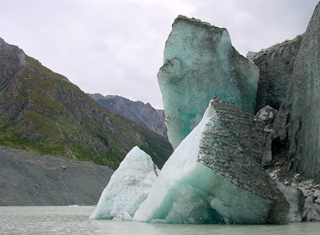| |
| |

Tasman Glacier retreat is extreme
24 April 2008, Massey University
The Tasman Glacier, New Zealand's largest glacier, is retreating faster than ever and will ultimately disappear, glaciologists are warning.
In 1973 there was no lake in front of the Tasman Glacier, says Dr Martin Brook, lecturer in physical geography at Massey University. New measurements indicate the lake, formed by ice melt from the glacier, is now 7km long, 2km wide and 245m deep.
“In the last 10 years the glacier has receded a hell of a lot,” Dr Brook says. “It’s just too warm for a glacier to be sustained at such a low altitude, 730m above sea level, so it melts rapidly and it is going to disappear altogether. The deeper the lake gets, the faster the retreat of the glacier.”
Dr Brook says the lake can only grow to a length of about 16km, which would mean a further 9km of glacier retreat. |
| |
 |
| |
New Zealand’s glaciers are shrinking ... twelve of the largest glaciers in the Southern Alps are unlikely to return to their earlier lengths. |
|
| |
 |
| |
“Using the empirical relationships between water depth and glacier retreat rate we could expect further retreat of between 477m and 822m each year. At these rates it would take between 10 and 19 years for the lake to expand to its maximum.”
His work indicated that an extreme scenario for the future retreat of the Tasman Glacier, developed by Dr Martin Kirkbride in the 1990s, was correct.
“The last major survey was in the 1990s and since then the glacier has retreated back 180 metres a year on average. This has exposed a huge rock basin which was eroded more than 20,000 years ago when the glacier was a lot larger and more powerful.”
The glacier previously followed a slow retreat phase for awhile. A thermo-erosional notch in the ice cliff face would develop at the water line, melt back into the glacier undercutting the ice above, causing the ice to collapse into the lake.
Now, a short foot of ice is extending out into the lake away from the ice cliff, and the glacier is in a period of fast retreat. As the water depth increases so does the speed of retreat, because a much larger part of the glacier is submerged and the water, even at only 2°C, is still able to melt the glacier ice. |
|
| |
|
Above: Images of the Mueller (bottom left), Hooker (left) and Tasman Glaciers on 30th December 1990 and 7th December 2007 show large increases in the sizes of terminus lakes during the 17-year period. The largest, Tasman Lake, has grown to a length of 16 km and width of 2 km, at the terminus of the Tasman Glacier.
In the false colour satellite images, lower glaciers appear as dark grey because of debris on the surface. Pale blue indicates ice and snow, deep blue indicates water, green indicates vegetation, and brown indicates bare ground or rock. Images: NASA
 View images of a larger area View images of a larger area |
|
| |
 |
| |
Tasman Lake at the terminus of Tasman Glacier. Image: Copyright © Jeffrey de Grijs, Jeffrey de Grijs Photography
 View larger image View larger image
|
|
| |
 |
| |
“The result is large pieces of ice fracturing off the ice foot and floating on the surface – the debris on the icebergs on the surface of the lake and the icebergs are a reflection of this.”
As well as addressing the future of the Tasman Glacier, which is in Aoraki Mt Cook National Park, the team is analysing the newly exposed sub-surface landscape. The project is also interested in the glacier because it is very different to the clean-ice glaciers on the West Coast.
Tasman Glacier is covered in rock and debris, and has a different relationship with climate, as well as different patterns of retreat.
Although there is a near-vertical ice cliff at the front of the glacier that terminates in the lake, there is actually a sub-surface apron of ice that slopes away under the water for at least 50m or 60m from the front of the glacier.
As this ice-apron melts, blocks of ice break off and float to the surface. This happens pretty quickly and is potentially a hazard for the tour boats that cruise up to the cliff – the blocks just pop out on the surface and some are between 5m and 10m in size. |
|
| |
 |
| |
Below clockwise: Tasman Lake at the terminus of Tasman Glacier; icebergs on Tasman Lake; glacial outwash and moraine below Tasman Lake; Lake Mueller at the terminus of Mueller Glacier. Photos Copyright © 2005 Department of Geography, University of Otago
 View larger images View larger images
|
|
| |
|
|



